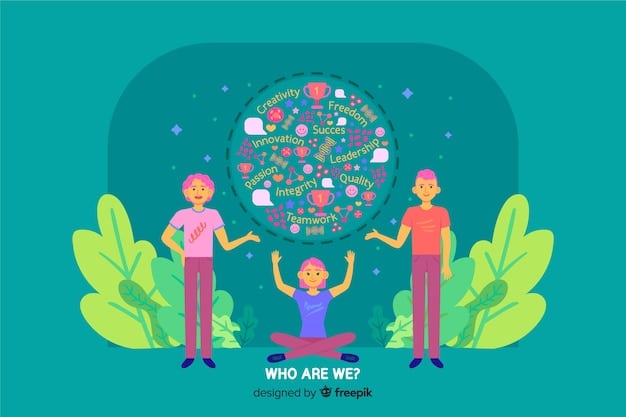Employee Assistance Programs: Your Secret for Overcoming Life Challenges

Advertisements
Employee Assistance Programs (EAPs) provide confidential, work-based intervention programs designed to assist employees in resolving personal problems that might adversely impact their job performance, health, and well-being, offering a vital resource for navigating life’s complexities.
In the whirlwind of modern life, navigating personal challenges while maintaining professional equilibrium can feel like an impossible task. Whether it’s mental health struggles, financial strain, or relationship issues, these stressors don’t magically disappear when you clock in. This is where Employee Assistance Programs (EAPs): Your Secret Weapon for Overcoming Life’s Challenges, step in, offering a crucial lifeline that many employees may not even realize they have access to.
understanding employee assistance programs (eaps)
Employee Assistance Programs (EAPs) are confidential, work-based intervention programs designed to help employees resolve personal problems that may be adversely affecting their job performance, health, and well-being. These programs are often offered by employers at no cost to their employees and can cover a wide spectrum of issues including mental health, substance abuse, financial difficulties, legal concerns, family problems, and workplace stress.
The core philosophy behind EAPs is rooted in the understanding that employee well-being directly impacts productivity, morale, and retention. By providing a readily accessible and confidential resource, organizations can support their workforce through difficult times, fostering a more resilient and engaged employee base. The services typically involve counseling, referrals, and resources for a variety of challenges, ensuring a holistic approach to employee support.
the evolution of eaps: from past to present
Originally, EAPs emerged in the mid-20th century primarily to address issues related to alcohol abuse in the workplace. Over time, their scope expanded significantly to encompass a broader range of personal and work-related problems. This evolution reflects a growing awareness among employers that a comprehensive approach to employee well-being is essential for a thriving workforce.
- Early EAPs focused almost exclusively on addiction recovery.
- Their mandate broadened to include mental health counseling in the late 20th century.
- Today, EAPs offer a holistic suite of services, from legal aid to childcare resources.
The modern EAP is a far cry from its predecessors, adapting to the complexities of contemporary life and work. They are designed to be proactive, helping employees address issues before they escalate and significantly impact their professional or personal lives. This preventive approach benefits both the employee and the employer.
how eaps work: confidentiality and accessibility
One of the most critical aspects of EAPs is their commitment to confidentiality. Employees can seek help without fear that their personal issues will be disclosed to their employer. This assurance encourages utilization, as privacy is paramount when dealing with sensitive matters. Accessibility is also a key feature, with services often available 24/7 through various channels like phone, online portals, and in-person sessions.
Accessing an EAP typically begins with a confidential call or online inquiry. A professional counselor assesses the employee’s needs and provides immediate support, short-term counseling, or referrals to specialized resources. The goal is to provide timely and effective assistance, empowering employees to navigate their challenges with professional guidance.
In essence, EAPs serve as a preventive and supportive measure, acknowledging that employees are whole individuals whose personal lives inevitably influence their professional capacity. By offering comprehensive support, EAPs help create a more human-centered workplace.
key benefits of eaps for employees
For employees, EAPs offer a confidential and readily available resource to navigate life’s complexities without feeling alone or overwhelmed. The benefits extend far beyond just crisis intervention, fostering a stronger sense of security and well-being.
One of the primary benefits is access to professional counseling. Many EAPs provide short-term mental health counseling for issues such as stress, depression, anxiety, grief, and relationship problems. This immediate, confidential support can be invaluable, especially when traditional mental health services might have long waiting lists or be cost-prohibitive.
mental health support: a critical component
In today’s fast-paced world, mental health challenges are increasingly prevalent. EAPs play a critical role in offering accessible mental health support, often serving as a first point of contact for individuals struggling with their emotional well-being. This can include anything from managing everyday stress to dealing with more severe conditions.
- Confidential counseling for stress, anxiety, and depression.
- Referrals to long-term therapy or specialized mental health providers.
- Support for coping with grief, loss, and trauma.
The confidential nature of EAP services is particularly vital for mental health support, reducing the stigma often associated with seeking help. Employees can address their concerns without fear of judgment or repercussions within the workplace, which is crucial for open and honest engagement with treatment.
financial and legal guidance: practical assistance
Beyond mental health, EAPs often extend their services to practical matters such as financial and legal guidance. Financial wellness is a significant contributor to overall well-being, and EAPs can connect employees with experts who provide budget counseling, debt management advice, and retirement planning. Similarly, legal consultations for issues like family law, estate planning, or property disputes can alleviate considerable stress.
These services empower employees to make informed decisions and take proactive steps to improve their financial security and resolve legal challenges. The availability of such diverse support under one program highlights the comprehensive nature of modern EAPs, addressing a wide array of factors that impact an employee’s life.
Essentially, EAPs offer a robust safety net, ensuring employees have somewhere to turn for reliable, professional assistance across various life domains. This broad support system underscores their value as a holistic resource for navigating day-to-day challenges.
eaps as a strategic asset for employers
For employers, investing in EAPs is not merely a philanthropic gesture; it’s a strategic decision that yields tangible benefits for the organization as a whole. A healthy and supported workforce is inherently more productive, engaged, and loyal, directly impacting the bottom line.
The return on investment (ROI) for EAPs is often seen in reduced absenteeism and improved productivity. When employees have resources to address personal issues, they are less likely to miss work or be distracted while on the job. This directly translates to more consistent performance and higher output.
boosting employee productivity and morale
A primary strategic benefit of EAPs for employers is their ability to enhance employee productivity and boost morale. When employees feel supported by their organization, their levels of engagement and dedication naturally increase. EAPs address underlying issues that can hinder performance, such as stress, mental health concerns, or financial worries, allowing employees to focus more effectively on their work tasks.
- Reduced presenteeism, where employees are physically present but unfocused.
- Improved job satisfaction due to feeling valued and supported.
- Increased ability to concentrate and meet deadlines.
By offering EAPs, companies demonstrate a genuine commitment to their employees’ well-being, fostering a positive workplace culture. This positive environment contributes significantly to higher morale, encouraging employees to be more innovative, cooperative, and dedicated to the company’s success.
reducing absenteeism and presenteeism
Absenteeism—employees being absent from work—and presenteeism—employees being at work but performing poorly due to illness or personal issues—are significant drains on productivity and resources. EAPs effectively combat both by providing immediate and confidential support for underlying problems. Employees can access counseling or resources to address issues before they lead to prolonged absences or reduced functionality at work.
For example, an employee struggling with anxiety might find immediate relief through EAP counseling, preventing them from taking sick leave or performing below par. Similarly, someone facing financial stress can get timely advice, helping them regain focus and reduce the mental burden that affects their work.

enhancing retention and recruitment
In today’s competitive job market, an attractive benefits package, including a robust EAP, can significantly enhance an employer’s ability to retain top talent and attract new recruits. Employees are increasingly prioritizing companies that demonstrate care for their overall well-being. An EAP signals that an organization values its people beyond just their professional output.
High employee turnover is costly, involving recruitment, training, and lost productivity. By supporting employees through challenging times, EAPs help foster loyalty and commitment, ultimately reducing turnover rates. This, in turn, strengthens the workforce, making the company a more desirable place to work.
Ultimately, EAPs serve as a powerful tool for employers to invest in their most valuable asset—their human capital. By prioritizing employee well-being, organizations build a more resilient, productive, and committed workforce, contributing to long-term success and sustainability.
common challenges and how to overcome them
Despite the undeniable benefits of EAPs, their full potential is often hampered by common challenges. These hurdles typically revolve around employee awareness, the stigma associated with seeking help, and ensuring the quality and accessibility of services. Addressing these issues is crucial for maximizing EAP effectiveness.
One of the most persistent challenges is a lack of awareness among employees about the existence and scope of their EAP. Many employees simply don’t know that these programs are available, or they misunderstand what services they offer. This knowledge gap prevents them from utilizing a valuable resource when they need it most.
lack of awareness and promotion
A significant stumbling block for EAP utilization is often the lack of adequate promotion and awareness within organizations. Employers might offer EAPs but fail to effectively communicate their existence and benefits to their workforce. This leads to low engagement rates, as employees cannot use a service they don’t know about.
- Regular communication through multiple channels (email, intranet, workshops).
- Highlighting specific benefits and success stories (anonymized).
- Integrating EAP information into new employee onboarding processes.
Effective promotion involves making information easily accessible and reiterating the confidential nature of the services. Employers should treat EAP promotion as an ongoing campaign rather than a one-time announcement, ensuring the message reaches all employees consistently.
stigma and confidentiality concerns
The stigma associated with seeking help for mental health, financial, or personal issues remains a formidable barrier. Employees may fear that utilizing an EAP could negatively impact their career, be perceived as a sign of weakness, or lead to their personal struggles being disclosed to their employer. These concerns, however unfounded, deter many from seeking assistance.
Overcoming this stigma requires continuous reassurance about the strict confidentiality protocols of EAPs. Clear communication about how personal data is protected and that employers do not receive information about who uses the service can build trust. Leadership should also model openness and support for mental health initiatives to create a culture where seeking help is normalized.
Ultimately, addressing these challenges head-on—through proactive communication, robust confidentiality measures, and a supportive organizational culture—is essential for transforming EAPs from underutilized benefits into indispensable resources for employees.
integrating eaps into a broader wellness strategy
For EAPs to truly flourish, they must be seamlessly integrated into an organization’s overall wellness strategy. This means moving beyond viewing EAPs as standalone benefits and instead seeing them as core components of a comprehensive approach to employee well-being. A holistic strategy recognizes that physical, mental, emotional, and financial health are interconnected.
Integrating EAPs allows for a more synergistic approach, where different wellness initiatives complement each other. For example, a company’s mental health awareness campaigns can direct employees to the EAP as a practical resource for support, while financial wellness workshops might guide employees to EAP counselors for personalized debt management advice.
holistic well-being: connecting physical and mental health
A robust wellness strategy acknowledges that physical and mental health are not separate entities but are deeply intertwined. An EAP, while often focused on mental and emotional support, can serve as a gateway to broader physical wellness resources. For instance, an EAP counselor might refer an employee struggling with stress to exercise programs or nutrition counseling that are part of the company’s other wellness offerings.
- Linking EAP services with fitness challenges or health screenings.
- Promoting stress reduction techniques that incorporate physical activity.
- Providing resources for sleep hygiene and balanced nutrition through EAP referrals.
This integrated approach ensures that employees receive comprehensive care, addressing the root causes of their challenges from multiple angles. It portrays a company that genuinely cares about every facet of its employees’ health, fostering a more resilient and healthy workforce.
data-driven improvements and feedback loops
To ensure EAPs remain relevant and effective, organizations should leverage data and establish robust feedback loops. While individual employee data remains confidential, aggregate usage data can provide valuable insights into the types of issues employees are facing, peak times for service utilization, and areas where additional support might be needed. This data can inform strategic improvements to the EAP and other wellness programs.

Collecting employee feedback on their EAP experiences through anonymous surveys or focus groups can also provide qualitative insights, helping to refine services and communication strategies. This continuous improvement cycle ensures that the EAP truly meets the evolving needs of the workforce, demonstrating an adaptive and responsive approach to employee well-being.
By integrating EAPs into a broader, data-driven wellness strategy, employers can create a truly supportive ecosystem that actively promotes and sustains the holistic well-being of their employees, benefiting both individuals and the organization.
future trends and the evolving role of eaps
The landscape of employee well-being is constantly evolving, driven by societal changes, technological advancements, and a growing understanding of mental health. EAPs are adapting to these shifts, broadening their scope and refining their delivery methods to remain relevant and impactful in the years ahead.
One significant trend is the increasing focus on preventive care and proactive interventions. Rather than merely reacting to crises, future EAPs will likely place greater emphasis on tools and resources that help employees build resilience, manage stress, and foster positive mental health before issues escalate.
eaps in the digital age: telehealth and apps
The digital transformation has profoundly impacted EAP delivery, with telehealth and wellness apps becoming increasingly central. Online platforms provide accessible and convenient avenues for counseling, mindfulness exercises, and self-help resources, breaking down geographical barriers and accommodating diverse schedules. This digital expansion has been particularly crucial in recent years, demonstrating the adaptability of EAPs.
- Virtual counseling sessions via video calls.
- Meditation and mindfulness apps integrated with EAP services.
- Digital self-assessment tools for early identification of issues.
These digital tools enhance accessibility and convenience, making it easier for employees to engage with EAP services on their own terms. The continued evolution of AI and data analytics may also personalize EAP recommendations, leading to even more tailored support for individuals.
addressing diverse workforce needs: DEI and global EAPs
As workforces become more diverse, EAPs are increasingly recognizing the importance of addressing specific needs related to diversity, equity, and inclusion (DEI). This includes providing culturally competent counseling, resources for LGBTQ+ employees, support for disability-related challenges, and services delivered in multiple languages to accommodate global teams. A truly effective EAP must reflect the rich tapestry of its user base.
The globalization of businesses also necessitates global EAPs that can cater to employees across different countries, respecting local cultural nuances and legal frameworks. This expansion ensures that all employees, regardless of their background or location, have access to relevant and empathetic support.
Ultimately, the future of EAPs is one marked by greater integration, personalization, and inclusivity. As they continue to evolve, EAPs will remain a vital component of holistic employee well-being, helping individuals and organizations thrive in an ever-changing world.
maximizing the impact of your company’s eap
To truly unlock the potential of your company’s EAP and transform it into a powerful tool for employee well-being, it’s essential to move beyond simply offering the program. Maximizing its impact requires strategic promotion, a supportive culture, and continuous evaluation.
The first step is to ensure that employees are not only aware of the EAP but also understand its full scope and benefits. Regular, multi-channel communication is key. This goes beyond a single announcement; it means consistently reminding employees about the resource through emails, intranet updates, team meetings, and even posters in common areas.
effective communication and continuous promotion
Consistent and clear communication is the cornerstone of a well-utilized EAP. It’s not enough to mention it once during onboarding. Employers should develop an ongoing communication strategy that highlights different aspects of the EAP throughout the year, tying it to relevant events or awareness months (e.g., Mental Health Awareness Month).
- Regular reminders through internal newsletters and company announcements.
- Highlighting testimonials (anonymized) to build trust and demonstrate effectiveness.
- Using diverse channels to reach all employees, including digital and physical touchpoints.
The message should always emphasize confidentiality, ease of access, and the wide range of services available. Reinforcing that the EAP is a proactive tool, not just for crisis, helps destigmatize its use.
leadership buy-in and a culture of support
The strongest EAPs are supported by strong leadership buy-in and a company culture that champions employee well-being. When senior leaders visibly endorse the EAP and demonstrate their commitment to mental health and personal support, it sends a powerful message to the entire workforce. Leaders can normalize seeking help by openly discussing the importance of well-being and by sharing (appropriately) how they prioritize their own health and resilience.
Creating a culture where employees feel safe and encouraged to seek help is paramount. This means fostering an environment of empathy, understanding, and trust where individuals are not judged for experiencing personal challenges. A supportive culture reinforces the value of the EAP and encourages its utilization, turning it into a truly integrated and effective part of the workplace ecosystem.
Ultimately, maximizing an EAP’s impact means treating it as an essential investment in human capital rather than a reactive measure. By strategically promoting it, embedding it within a supportive culture, and continuously evaluating its effectiveness, organizations can empower their employees to overcome life’s challenges and thrive both personally and professionally.
| Key Point | Brief Description |
|---|---|
| 💡 Access & Confidentiality | EAPs offer private, secure support for diverse personal issues without employer notification. |
| 🧠 Holistic Support | Beyond mental health, EAPs provide financial, legal, and work-life balance guidance. |
| 📈 Employer Benefits | Improve productivity, reduce absenteeism, boost morale, and enhance talent retention. |
| 🚀 Future Evolution | Integrating more digital tools and focusing on proactive, personalized, and diverse support. |
frequently asked questions about eaps
EAPs are designed to assist with a wide range of personal and work-related issues. This includes mental health concerns like stress, anxiety, and depression, as well as substance abuse, relationship problems, financial difficulties, legal questions, and challenges related to grief and loss. They aim to provide comprehensive support for your overall well-being.
Yes, confidentiality is a cornerstone of EAPs. All interactions with EAP providers are strictly confidential. Your employer will not be informed about your participation, the nature of your issues, or any details of your sessions. This anonymity encourages employees to seek needed support without fear of professional repercussions.
Access methods vary by company but typically include a dedicated toll-free phone number, a website, or a mobile app provided by your employer. Many EAPs offer 24/7 access to counselors or resources. Details are usually found in your employee benefits guide, HR portal, or by contacting your human resources department.
Generally, EAPs are a benefit fully paid for by your employer, meaning there is no direct cost to employees for the short-term counseling, referrals, or resources provided. However, if an EAP refers you to external, long-term services (like ongoing therapy), those may involve costs covered by your health insurance or out-of-pocket, depending on your plan.
Many EAPs extend their services to immediate family members of employees, including spouses, domestic partners, and dependent children. It’s crucial to check with your specific EAP provider or HR department regarding the eligibility of family members, as coverage can vary between programs and organizations.
conclusion
In a world where personal and professional pressures frequently intertwine, Employee Assistance Programs (EAPs) stand as indispensable allies. Far more than just a reactive measure, they represent a proactive investment in the holistic well-being of a workforce. By offering confidential support across a spectrum of challenges—from mental health and financial stress to legal issues and personal crises—EAPs empower individuals to navigate life’s complexities with greater resilience. For employers, these programs translate directly into tangible benefits: enhanced productivity, reduced absenteeism, improved morale, and a stronger, more stable workforce. As EAPs continue to evolve with technology and expand their reach to meet diverse needs, their role as a “secret weapon” for overcoming life’s challenges will only grow, fostering healthier, happier, and more productive environments for everyone involved.





